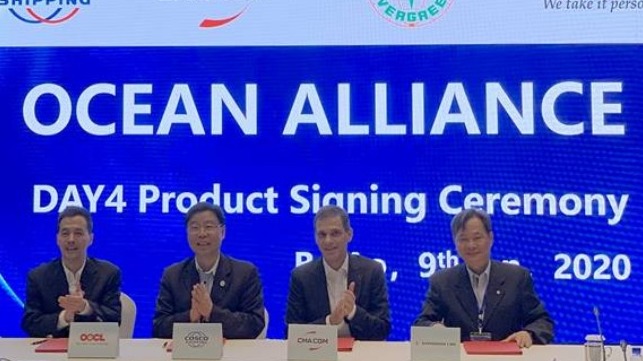South Korean carrier HMM’s latest ULCV, the HMM Algeciras, which at 23,964 teu is the world’s largest boxship, made its maiden call at Hamburg yesterday, exchanging some 13,600 teu in a single call.
The fate of the vessel remains unclear however, as it has been deployed on THE Alliance’s Asian-North Europe FE4 service, which is shortly to be merged with the FE2 string; alliance members rationalising capacity in the wake of the demand drop due to coronavirus.
However, its sister ships, the HMM Oslo and HMM Copenhagen, are already assigned to the FE2 and it would be little surprise to see HMM Algeciras joining them.
Meanwhile, responding to last week’s news that the HMM has the highest proportion of idled vessels among the world’s deesea carriers, a representative for the line said that, despite the uncertain prospects for container trades, the number of idled vessels was a “temporary” measure that would reversed by the end of the summer.
“HMM has idled its container fleet from a strategic viewpoint in the course of proactively responding to sharp decrease in demand due to Covid-19 pandemic,” a spokesperson told The Loadstar.
“In addition, in terms of operating fleet, we are in the midst of our transition from the 2M to THE Alliance, which led to temporarily high level of idle vessels.

The widespread removal of capacity across most of the world’s shipping trades via blank sailings and the withdrawal of services been the primary reasons that freight rates in recent weeks have managed to remain relatively high, and the HMM spokesperson further claimed that “at least at this stage, HMM does not believe temporary idling of vessels has become a burden in light of its business performance”.
“Strategic fleet operation, given the unfavourable market environment, has been required more than ever to keep our business profitable. In fact, HMM has improved its financial result in Q1 2020.”
Last week, Alphaliner data showed HMM has almost 200,000 teu currently idled, amounting to 32.9% of its fleet – however, measured in teu, this is dwarfed by Maersk and MSC.
It said: “2M partners Maersk and MSC account for the bulk of the inactive fleet, with a combined total of 854,000 teu.
“However, more than half of this vessel inactivity is due to scrubber installations. MSC in particular still has a significant part of its fleet undergoing retrofit work at shipyards in China and Turkey.”
And HMM confirmed it was in a similar situation: “Half of [our] idle vessels are currently either on dry-docking for scrubber installation or waiting for service deployment shortly.”
And as social lockdowns around the world begin to ease the carrier predicted that more ships would begin to be reactivated.
“The majority of the remainder of the idled flet is also scheduled to be sequentially deployed largely on transpacific (USWC/EC) and India trades by the end of July; thereby the portion of our inactive fleet will be down to around 10% by the end of September,” the spokesperson added.
THE Alliance announced its third-quarter blanking programme last week, and today liner analyst SeaIntelligence Consulting warned that in the past two weeks alone there had been an additional 20 blank sailing announcements on the transpacific and 24 on Asia-Europe, and suggested more announcements were on their way, most likely from the Ocean Alliance members.

“If we look at the blank sailings announcements on an individual alliance level, we get the clearest indication that there will be announcements in the coming weeks; both 2M and Ocean Alliance have only announced a 2% capacity reduction on Asia-North America west coast, while Ocean Alliance are yet to announce any blank sailings on the other major east-west trades,” said SeaIntelligence chief executive Alan Murphy.
“It is likely that they are following the trend that we have seen so far, where they are typically the last of the three alliances to announce blank sailings,” he added.













